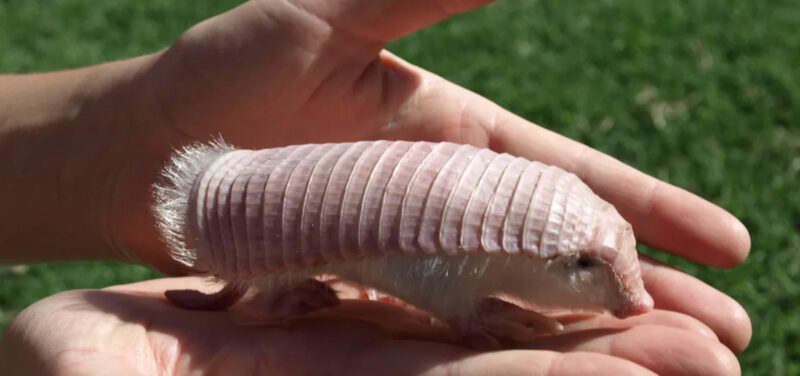The pink fairy armadillo is the smallest species of armadillo on the planet. The weird-looking, hamster-sized creature stands out because of its pink dorsal shield and tufts of white fur. It seems to be wearing a pink cape over an Angora sweater.
A new study identifies something even more unusual about it. It is the only mammal with a double layer of skin.
Scientists made the discovery after looking at the little armadillo’s skin through a microscope. This second layer of skin lies underneath the armadillo’s pink dorsal shield.
There are 20 species of armadillo on Earth. The other 19 have a single layer of skin on their back, which is covered with osteoderms — bony deposits that form plates embedded in the skin — and scales that make up their dorsal plate.
The skin of the pink fairy armadillos most closely resembles that of juvenile armadillos of other species. The dorsal shield splits into multiple sections, unlike with other armadillos. One shield covers the head. Another covers the rest of the body.
Adapted to scurry through tunnels
This larger dorsal shield splits again into two sections, one on the upper back, and the other over its rear end. These sections feature moveable bands, making it easier for the armadillos to scurry around underground tunnels.
“The flexibility and lightness of the dorsal shield enable it to adapt to the shape of the tunnels,” said Cecilia Krmpotic, lead author of a new study.

The pink fairy armadillo. Photo: Guillermo Ferraris/Mariella Superina
While other armadillos spend most of their time on the surface, the pink fairy armadillo is nearly always underground. “The evolution toward a completely subterranean lifestyle…[took] place between 32 and 17 million years ago,” Krmpotic said.
Because of their hidden underground lives, the creatures are incredibly difficult to study. Krmpotic has never actually seen one. She was looking at dead specimens from a lab. In the wild, they live in Argentina and spend almost all their lives underground. Most of what we know about them comes from studying those in captivity.
Rarely survive in captivity
However, very few pink fairy armadillos survive away from their natural environment. Around 95% of those taken out of their habitat die within a week.
Mariella Superina, a leading expert on armadillos, has studied them for decades and has seen a number of live critters. Mostly, those who have been forced out of their tunnels by flooding. Others have been young males that have popped up on roads and trails. These juvenile males leave their mothers between February and March, and that’s when they appear. If they hit pavement while digging, they surface to cross the road. Completely adapted to living underground, the armadillos fare poorly on the surface.
“I’ve talked to many locals who have lived their entire life in the desert of Mendoza, and those who’ve seen a pink fairy armadillo remembered that encounter very well,” Superina told IFL Science. “One woman who lived over 80 years on a farm in the desert told me that she had seen three in her entire life…Isn’t it amazing that there’s a tiny little animal out there that is so rarely seen, can’t be tracked by the locals, and can’t be trapped with traditional methods?”






